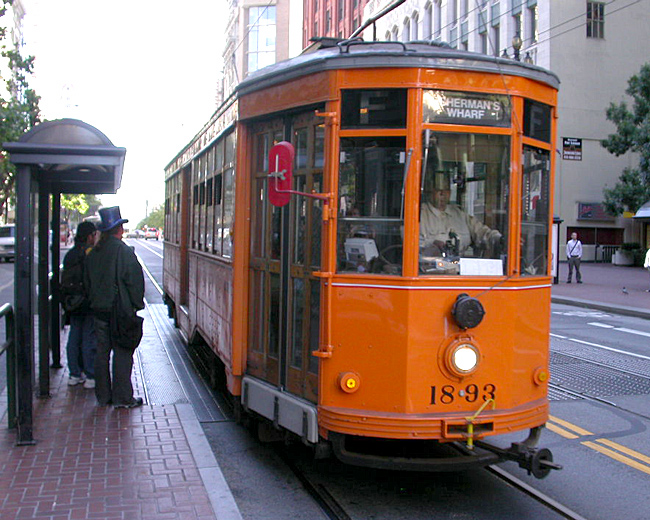E-Line Historic Streetcars: A Transit Difference-Maker
 Starting weekends on August 1, 2015, the new E-Line Historic Streetcars will run along the Embarcadero, connecting the Caltrain Station to Fisherman’s Wharf. In 2016, daily service will begin. And someday, the E-Line will extend from the Caltrain Station/ AT&T Ballpark all the way to Aquatic Park/ Fort Mason. The concept of Market Street historic streetcars was first proposed by San Francisco Tomorrow in 1971.
Starting weekends on August 1, 2015, the new E-Line Historic Streetcars will run along the Embarcadero, connecting the Caltrain Station to Fisherman’s Wharf. In 2016, daily service will begin. And someday, the E-Line will extend from the Caltrain Station/ AT&T Ballpark all the way to Aquatic Park/ Fort Mason. The concept of Market Street historic streetcars was first proposed by San Francisco Tomorrow in 1971.
EXAMINER: Anticipated E-line ready to roll
http://www.sfexaminer.com/muni-set-to-roll-out-long-planned-waterfront-streetcar-the-e-line/
The E would run from the foot of the Embarcadero Freeway past Fisherman’s Wharf to Fort Mason.
Originally conceived by San Francisco Tomorrow in the 1970s, it wasn’t until Feinstein backed the project in the ’80s that the trolley’s future was secured.
Fast forward some three decades, and the E has yet to launch, but there is light at the end of the tunnel.
Muni’s E-Embarcadero will finally roll starting Aug. 1 [2015].
Though the launch is close, the “E dream” still is not fully realized. The last leg of the trip — chugging the trolley down to Fort Mason — is still in planning phases.
“What I’m happy about is that the streetcars themselves have proven public transit doesn’t have to be dowdy or dirty,” Laubscher [Market Street Railway] told the San Francisco Examiner. “You can draw people out of their automobiles willingly, if you give them a truly attractive alternative.”
He’s referring to the physical beauty of the streetcars. They often feature wood paneling and art deco light fixtures, like public transit out of a 1940s film noir story.
MARKET STREET RAILWAY: “Great E-Line Startup Piece in Examiner”, July 15, 2015
The Examiner’s Joe Fitzgerald Rodriguez gave us a ring in the morning, asking for the history behind the E-line. Among other things, he was curious why the line is named E when it’s starting service 20 years after the F. We explained that the E-Embarcadero was originally given that letter in 1979, when Muni Planning first included it in its Long Range Transit Plan (very long range, as it turned out). It was envisioned to run from Fort Mason to the Caltrain Depot along the waterfront, following the old State Belt freight railroad route, an idea first proposed a decade earlier by San Francisco Tomorrow. The following year, they included the F-Market in their plan from the Ferry to Castro.
SAN FRANCISCO TOMORROW’S 1971 HISTORIC STREETCAR PROPOSAL
In March 1971, San Francisco Tomorrow (SFT) got the E-Line and F-Line idea rolling with its paper: “A Concept for the Market Street Railway Restoration”—written by Gerald Fox, active in SFT and an engineer (who worked for De Leuw, Cather and Company—later acquired by Parsons).
Excerpts From Proposal:
This presentation explores an alternative concept; the retention of streetcar service, using restored or newly-built “old-time” streetcars. They would operate the length of Market Street on the permanent-type track, now being restored by BART. The cost of removing this track may well be greater than the cost of providing the small additional facilities necessary for the proposed operation, which, as a feature comparable to the enduringly popular cable cars, would add immeasurably to the atmosphere and attractiveness of the Bay Area’s most famous street.
We have in our midst the world-famous cable cars, offering a daily reminder that transportation does not always have to be dull, utilitarian, polluting and noisy. A service extending the cable car concept to Market Street would not only satisfy the necessity for transit but would draw people and business to an attractive and friendly street. There also will be, after 1973, a pair of unused streetcar tracks almost the whole length of Market Street, and most of it will have been newly laid, using the finest new materials, over the BART stations and Muni subway excavations.
QUICKER AND CHEAPER MUNI IMPROVEMENTS
The Examiner article above sagely notes that even old streetcars, which are beautiful, clean and well-maintained, will attract riders and get people out of cars. San Francisco Tomorrow has advocated for such quick, low-cost transit improvements. For instance, modernizing all 15 bus/ cable car/ streetcar lines in the northeast quadrant would transform transit in ten neighborhoods—rather than huge inefficient spending along the Central Subway route. Another concept is Free Shuttle Loop Buses—the hottest transit trend in the U.S. that has many funding models, such as the consolidation of expenditures by separate commuter shuttles. The City of Mountain View started its Free Shuttle Loop Bus with funding by Google.
MOUNTAIN VIEW: “Free shuttle to connect tech companies and downtown”
http://www.mv-voice.com/news/2014/12/10/free-shuttle-to-connect-tech-companies-and-downtown
The service will be a consolidation of five separate employer shuttle systems. “Through this consolidation, approximately 12,000 shuttle vehicle miles are saved per year,” said Denise Pinkston, chair of the board operating the system.
The biggest employers and office developers in the city are paying for the service, including Google and LinkedIn, thanks to a requirement placed on new office development by the Mountain View City Council.
TRANSPORT POLITIC: “Cities Develop Alternative Bus Networks to Combat Perceived Disadvantages of Mainline Routes.”
“Baltimore’s new transit network, which supplements the city’s metro rail, light rail, commuter rail, and bus routes, is the most recent example of a trend that has taken American cities by storm: The creation of auxiliary routes for the inner-city that are designed for frequent, high-quality service with the goal of attracting onto buses people who aren’t used to public transportation.”
— Howard Wong, AIA

